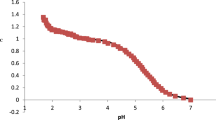Abstract
The acid-catalysed hydrolysis of [Co(trpn)(CO3)]+ and [Co(trpn)(HCO3)]2+ ions (trpn = 3,3′,3′′-triaminotripropylamine) have been studied spectrophotometrically in aqueous 1.0m HClO4/NaClO4. For the carbonato complex, [HClO4] = 0.02–0.25m and T = 20–35°C; for the bicarbonato complex, [HClO4] = 0.025–0.30m and T = 25°C. Both complexes hydrolyse to form the same cis-diaqua species. The rate law for the hydrolysis is d(ln[CoIII])/dt = k0+k1[H3O+]. The values of the rate constants (25°C), ΔH‡ (kJmol−1) and ΔS‡ (Jmol−1K−1)are:[Co(trpn)(CO3)]+,k0 = (1.7±0.6)× 10−4s−1, ΔH‡ 0 = 57±21, Δ S‡ 0 = −126±75; k1 = (1.0 ±0.1)×10−2m−1s−1, ΔHDagger;1 = 62±8, Δ S‡1 = −75 ±21, and for [Co(trpn)(HCO3)]2+, k0 = (2.9±0.7)× 10−4s−1, and k1 = (7.8±1.0)×10−2m−1s−1. The carbonato complex exhibits a deuterium isotope effect with k1D/k1H = 1.9, consistent with a rapid pre-equilibrium protonation, followed by rate-controlling ring-opening. The rate constants k0 and k1 (25°C and μ = 1.0m) for the ring-opening decarboxylation of the two systems studied lie within the experimental error. The results are compared with o ther related systems and the factors which influence the ring-opening decarboxylation (steric hindrance, ring strain, electron-donor ability of the amines) are discussed. The k1 path is interpreted in terms of concerted ring-opening and bond-making in the highly unstable aquabicarbonato intermediate.
Similar content being viewed by others
References
Ligand abbreviations: trpn = 3,3′,3″-triaminotripropylamine; tren = 2,22,2″-triaminotriethylamine; trien = 1,8-diamino-3,6-diazaoctane; Me2trien = 3,6-dimethyl-1,8-diamino-3,6-diazaoctane; en = 1,2-diaminoethane; pn = 1,2-diaminopropane; tn = 1,3-diaminopropane; bmen = N, N2-dimethyl-1,2-diaminoethane; tme = 2,3-diamino-2,3-dimethylbutane; py = pyridine.
S. S. Massoud and R. B. Jordan, Inorg. Chim. Acta, 221, 9 (1994), and reference cited therein.
D. A. Palmer and R. van Eldik, Coord. Chem., 83, 651 (1983).
R. W. Hay and B. Jeragh, J. Chem. Soc., Dalton Trans., 1343 (1979).
G. M. Harris and K. E. Hyde, Inorg. Chem., 17, 1892 (1978).
T. P. Dasgupta and G. M. Harris, J. Am. Chem. Soc., 93, 91 (1971).
F. A. Posey and H. Taube, J. Am. Chem. Soc., 75, 4099 (1953).
D. J. Francis and R. B. Jordan, Inorg. Chem., 11, 461 (1972).
F. D. Baeta, S. A. Bajue and T. P. Dasgupta, J. Chem. Soc., Dalton Trans., 599 (1990).
T. P. Dasgupta, Inorg. Chim. Acta, 20, 33 (1976).
D. J. Francis and G. H. Searle, Aust. J. Chem., 27, 269 (1974).
J. A. Kerhohan and J. F. Endicott, J. Am. Chem. Soc., 91, 6977 (1969).
R. W. Hay and B. Jeragh, Transition Met. Chem., 4, 288 (1979); 5, 252 (1980).
S. S. Massoud and R. M. Milburn, Polyhedron, 8, 275 (1988).
S. S. Massoud and R. M. Milburn, Polyhedron, 8, 415 (1988).
S. S. Massoud and M. A. Haiza, Polyhedron, 11, 1443 (1992).
J. A. Laurino, S. Knapp and H. J. Schugar, Inorg. Chem., 17, 2027 (1978).
S. S. Massoud and R. M. Milburn, Inorg. Chem. Acta., 154, 115 (1988).
J. A. Connolly, M. Banaszczyk, R. C. Hynes and J. Chin, Inorg. Chem., 33, 665 (1994); S. S. Massoud, Ph.D. thesis, Boston University, Boston, MA, USA (1985).
V. S. Sastri and G. M. Harris, J. Am. Chem. Soc., 92, 2943 (1970).
E. L. Purlee, J. Am. Chem. Soc., 81, 263 (1959).
A. Dei, P. Paoletti and A. Vacca, Inorg. Chem., 7, 865 (1968).
G. A. Barclay and B. F. Hoskins, J. Chem. Soc., 586 (1962).
P. C. Healy, C. H. L. Kennard, G. Smith and A. H. White, Cryst. Struct. Commun., 10, 883 (1981).
F. Bigoli, M. Lanfranchi, E. Leporati and M. Pellinghelli, Cryst. Struct. Commun., 9, 1261 (1980).
R. J. Geue and M. R. Snow, J. Chem Soc. A, 2981 (1971).
T. P. Dasgupta and G. M. Harris, J. Am. Chem. Soc., 97, 1733 (1975).
Author information
Authors and Affiliations
Rights and permissions
About this article
Cite this article
Massoud, S.S. Kinetics and mechanism of decarboxylation of cis-carbonato- and bicarbonato(3,3′,3′′-triaminotripropylamine)cobalt(III) ions. Transition Metal Chemistry 22, 304–308 (1997). https://doi.org/10.1023/A:1018485012656
Published:
Issue Date:
DOI: https://doi.org/10.1023/A:1018485012656




